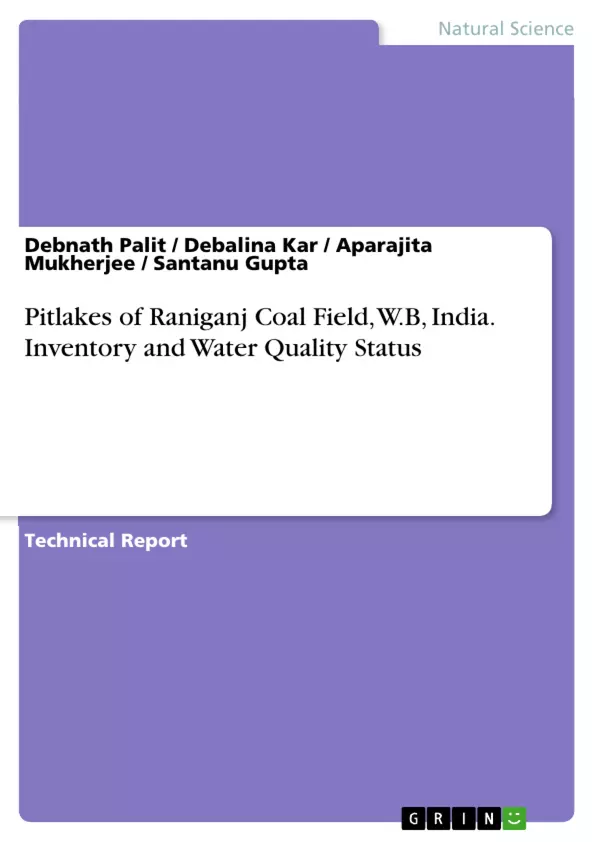The primary goal of this study was to prepare an inventory of Pit lakes in Raniganj Coal Field (RCF), West Bengal, India along with status of water quality in these pit lakes for promoting sustainable utilisation of the Pitlake resources for socioeconomic development of the local stake holders in due course of time. A comprehensive water quality and biological monitoring programme is strongly recommended for these pit lakes in order to be able to predict and manage risks and best utilise the opportunities provided by the pit lakes for the RCF region economy.
Table of Contents
- Preface
Objectives and Key Themes
The primary objective of this study was to create an inventory of pit lakes in the Raniganj Coal Field (RCF), West Bengal, India, and assess their water quality. The goal is to promote the sustainable use of these pit lake resources for the socioeconomic development of local stakeholders.
- Inventory of pit lakes in the Raniganj Coal Field.
- Assessment of water quality in the pit lakes.
- Sustainable utilization of pit lake resources.
- Socioeconomic development of local stakeholders.
- Recommendation for a comprehensive water quality and biological monitoring program.
Chapter Summaries
Preface: This preface briefly introduces the history of coal mining in the Raniganj Coalfield (RCF), beginning in 1774 during the British East India period. It highlights the significant landscape changes resulting from surface mining, specifically the formation of overburden dumps, voids, and pit lake ecosystems. The preface sets the stage for the study by explaining the formation of pit lakes in open-cut mines and their dependence on groundwater, surface water, and rainfall once dewatering ceases. It also emphasizes the study's aim to inventory these pit lakes, assess their water quality, and explore their potential for sustainable utilization and socioeconomic development within the RCF region. The need for a comprehensive monitoring program to manage risks and optimize opportunities presented by these pit lakes is also underscored.
Keywords
Pit lakes, Raniganj Coal Field, water quality, sustainable utilization, socioeconomic development, inventory, West Bengal, India, coal mining, environmental impact, wetland ecology, conservation biology, phytoremidiation.
Frequently Asked Questions: Raniganj Coal Field Pit Lake Study
What is the main objective of this study?
The primary objective is to create a comprehensive inventory of pit lakes in the Raniganj Coal Field (RCF), West Bengal, India, assess their water quality, and explore their sustainable use for the socioeconomic benefit of local communities. A key aspect is recommending a comprehensive water quality and biological monitoring program.
What key themes are explored in this study?
The study focuses on several key themes: inventorying pit lakes in the RCF, assessing their water quality, identifying possibilities for sustainable resource utilization, promoting socioeconomic development for local stakeholders, and recommending a comprehensive monitoring program for risk management and opportunity optimization.
What is included in the study's contents?
This document provides a comprehensive preview including a table of contents, objectives and key themes, chapter summaries (currently only a preface summary is provided), and keywords. It aims to give a complete overview of the study's scope and findings.
What is the context of the pit lakes?
The pit lakes formed as a result of coal mining activities in the Raniganj Coal Field, which has a long history dating back to 1774. Surface mining significantly altered the landscape, creating overburden dumps, voids, and the pit lakes themselves. The lakes' water sources are a combination of groundwater, surface water, and rainfall after dewatering ceases.
What are the potential benefits of this study?
The study aims to contribute to the sustainable use of pit lake resources, leading to socioeconomic development in the RCF region. By understanding the water quality and ecological characteristics of these lakes, the study will help inform better management practices and potentially unlock opportunities for local communities.
What keywords are associated with this study?
Keywords include: Pit lakes, Raniganj Coal Field, water quality, sustainable utilization, socioeconomic development, inventory, West Bengal, India, coal mining, environmental impact, wetland ecology, conservation biology, and phytoremidiation.
What is covered in the Preface?
The preface provides background information on the history of coal mining in the Raniganj Coalfield, focusing on the landscape changes resulting from surface mining and the subsequent formation of pit lakes. It emphasizes the study's goals: inventorying pit lakes, assessing their water quality, exploring their sustainable use, and promoting socioeconomic development. The need for a comprehensive monitoring program is also highlighted.
- Citation du texte
- Debnath Palit (Auteur), Debalina Kar (Auteur), Aparajita Mukherjee (Auteur), Santanu Gupta (Auteur), 2014, Pitlakes of Raniganj Coal Field, W.B, India. Inventory and Water Quality Status, Munich, GRIN Verlag, https://www.grin.com/document/270503



